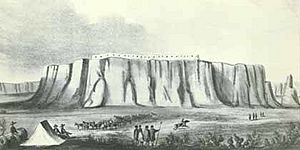Acoma Massacre facts for kids
Quick facts for kids Acoma Massacre |
|||||||
|---|---|---|---|---|---|---|---|
| Part of the Acoma War, Conquest of New Mexico | |||||||
 A lithograph of Acoma Pueblo made in 1848. |
|||||||
|
|||||||
| Belligerents | |||||||
| Acoma | |||||||
| Commanders and leaders | |||||||
| Zutacapan | |||||||
| Strength | |||||||
| ~70 conquistadors ~Indian auxiliaries ~1 artillery piece |
~2,000 warriors | ||||||
| Casualties and losses | |||||||
| unknown | ~500 killed ~500 captured |
||||||
| Civilian casualties ≈300 killed | |||||||
The Acoma Massacre was a terrible event that happened in January 1599. Spanish soldiers, called conquistadors, attacked the Acoma Pueblo in what is now New Mexico. This attack led to the deaths of about 500 Acoma men during a three-day battle. Around 300 Acoma women and children also died. Many Acoma people who survived were forced into labor for 20 years.
This event was a battle between Spanish colonizers and Native Americans from the Keres Acoma Nation. It was in revenge for the Acoma people killing 12 Spanish soldiers the year before.
Contents
Why Did the Acoma Massacre Happen?
In the late 1500s, the Spanish King wanted to take control of new lands. They began sending groups to conquer areas where Pueblo people lived. These areas were part of Spain's plan to expand its empire, which they called New Spain.
In 1595, a conquistador named Juan de Oñate got permission from King Philip II to colonize Santa Fe de Nuevo México. This area is now the American state of New Mexico.
At first, the Spanish and the Acoma people had mostly peaceful meetings. The Acoma people were much larger in number than the Spanish. However, in 1598, Zutacapan, a leader of the Acoma people, found out something important. He learned that the Spanish planned to take over Acoma Pueblo by force.
The Spanish also wanted all Pueblo people to move to a new village. There, they would live under Spanish rule. They would be forced to work for the Spanish King. This system was called encomienda. The Acoma people would also have to change their religion to Catholicism. They would have to give up their traditional beliefs. To protect their land and their way of life, the Acoma leaders decided to fight back.
Juan de Zaldívar, who was Oñate's nephew and a soldier, went to the Acoma pueblo. He arrived on December 4, 1598. The Spanish group demanded food and a place to stay for Zaldívar and his sixteen men. When the Acoma refused, the Spanish reportedly broke into homes. They destroyed property to take corn and blankets by force. The Acoma people fought back. In the fight, Zaldívar and eleven of his men were killed.
When Oñate heard about this, he was very angry. He ordered Juan's brother, Vicente de Zaldívar, to lead a group to punish the Acoma. This was meant to be a warning to other Pueblo groups. Vicente de Zaldívar took about seventy men. He left San Juan Pueblo in late December or early January. They arrived at Acoma on January 21, 1599.
The Battle at Acoma
The main battle between the Acoma and the Spanish started the next morning, January 22. For the first two days, the Acoma people were able to defend their home. They held off the Spanish forces. Then, Zaldívar came up with a plan. He decided to use a small cannon to break through the Pueblo's defenses.
On the third day, Zaldívar and twelve of his men climbed the mesa. They began firing the cannon at the Pueblo. The Spanish had powerful artillery, which the Acoma did not have. A large fire started and burned many Acoma homes during the battle. The conquistadors then rushed into the settlement.
In 1598, about 4,000 people lived at or near the Acoma Pueblo. At least 1,000 of them were warriors. During the battle, about 500 Acoma men were killed. Around 300 women and children also died. About 500 Acoma people were captured.
Oñate later held a trial for the captured Acoma people. He ordered harsh punishments. All males over 25 years old were forced into labor for twenty years. Males between 12 and 25, and all females over 12, were also forced into labor for twenty years.
Most of the remaining Acoma people were sent to live with Spanish officials or at Franciscan missions. Sixty of the youngest women were not punished. They were sent to Mexico City to live in Catholic convents. Two Hopi men were also captured at the pueblo. They were later released. This was done so they could spread the word about Spain's power. After the massacre, the Acoma people left their town because they were afraid. But they rebuilt it in 1599.
What Happened After?
When King Philip heard about the massacre and the harsh punishments, he was not pleased. Oñate was banned from New Mexico because he was so cruel to the native people. He later went back to Spain to live out his life. Some Acoma people escaped capture in 1599. By 1601, they had rebuilt their pueblo. It still stands today.
Acoma Views Today
The Acoma Massacre is still a very sensitive topic for the Pueblo people.
On April 21, 2007, a large statue of Oñate was put up in El Paso, Texas. It was 18 feet tall. Members of the Acoma tribe came to the ceremony. They protested against the statue being built.
On June 15, 2020, another statue of Oñate in Alcalde was taken down. Officials from Rio Arriba County removed it for safekeeping. They said they had not decided what to do with the statue. La Jornada, another statue of Oñate in Albuquerque, New Mexico, was also removed by local government officials during protests.

